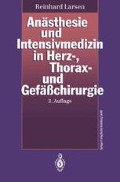Zusammenfassung
Die Häufigkeit angeborener Herzfehler beträgt in der Bundesrepublik Deutschland etwa 8%o, bezogen auf die Zahl der Lebendgeburten. Das sind rund 4000 angeborene Herzfehler pro Jahr. Die Ursachen der kongenitalen Herzfehler sind zumeist unbekannt. Interaktionen zwischen Umwelt und Genen sollen eine wesentliche Rolle spielen. Gesichert sind folgende krankheitsauslösenden Noxen:
-
Rötelnvirus,
-
Thalidomid (Contergan),
-
Folsäureantagonisten.
Access this chapter
Tax calculation will be finalised at checkout
Purchases are for personal use only
Preview
Unable to display preview. Download preview PDF.
Literatur
Borrow KM, Grenn LH, Castaneda AR et al. (1982) Left ventricular function after repair of tetralogy of Fallot and its relationship to age at surgery. Circulation 61:1150
Crawford FA, Sade RM (1984) Spinal cord injury associated with hyperthermia during coarctation repair. J Thorac Cardiovasc Surg 87:616
Donahoo JS, Roland JM, Ken J et al. (1981) Prostaglandin E1 as an adjunct to emergency cardiac operation in neonates. J Thorac Surg 81:227
Friedman WF, Heiferman MF (1982) Clinical problems of postoperative pulmonary vascular disease. Am J Cardiol 50:631
Hickey PR, Hansen DD, Norwood WI et al. (1984) Anesthetic complications in surgery for congenital heart disease. Anesth Analg 63:657
Hickey PR, Hansen DD, Cramolini GM et al. (1985) Pulmonary and systemic hemodynamic responses to ketamine in infants with normal and elevated pulmonary vascular resistance. Anesthesiology 62:287
Lang P, Gordan D (1985) Neonatal and pediatric intensive care. PSG Publishing, Boston
Moulton AL (1984) Congenital Heart Surgery. Current techniques and controversies. Butterworths, London
Morray JP, Lynn AM, Stamm SJ et al. (1984) Hemodynamic effects of ketamine in children with congenital heart disease. Anesth Analg 63:895
Radnay PA, Nagashima (1980) Anesthetic considerations for pediatric cardiac surgery. International Anesthesiology Clinics, Vol 18/1. Little Brown, Boston
Wadouh F, Lindemann EM, Arndt CF et al. (1984) The arteria radicularis magna anterior as a decisive factor influencing spinal cord damage during aortic occlusion. J Thorac Cardiovasc Surg 88:1
Author information
Authors and Affiliations
Rights and permissions
Copyright information
© 1993 Springer-Verlag Berlin Heidelberg
About this chapter
Cite this chapter
Larsen, R. (1993). Anästhesie und Intensivmedizin bei kongenitalen Herzfehlern. In: Anästhesie und Intensivmedizin in Herz-, Thorax- und Gefäßchirurgie. Springer, Berlin, Heidelberg. https://doi.org/10.1007/978-3-662-11142-0_10
Download citation
DOI: https://doi.org/10.1007/978-3-662-11142-0_10
Publisher Name: Springer, Berlin, Heidelberg
Print ISBN: 978-3-540-57172-8
Online ISBN: 978-3-662-11142-0
eBook Packages: Springer Book Archive

